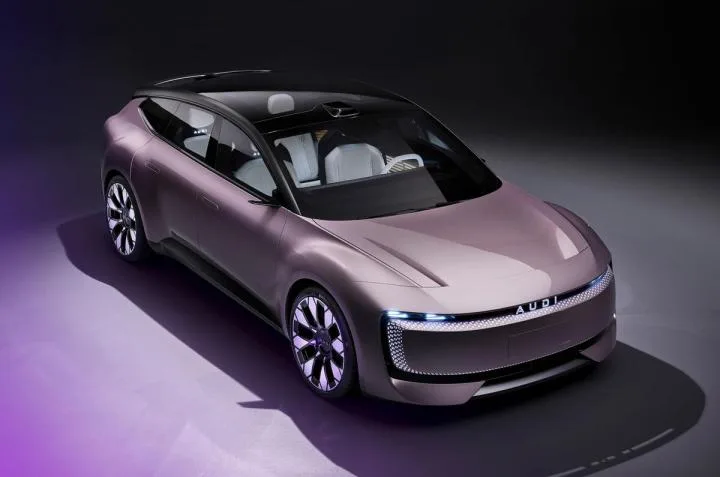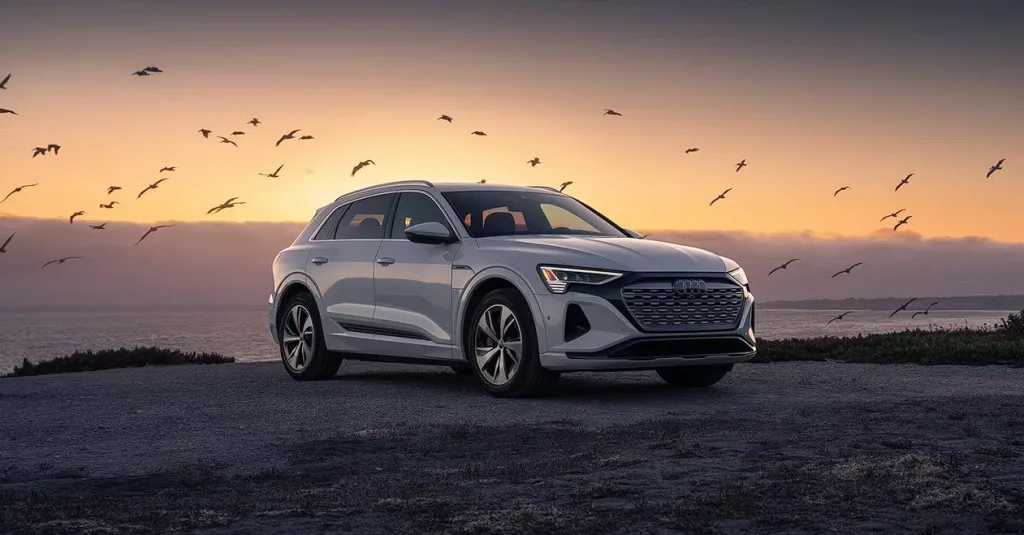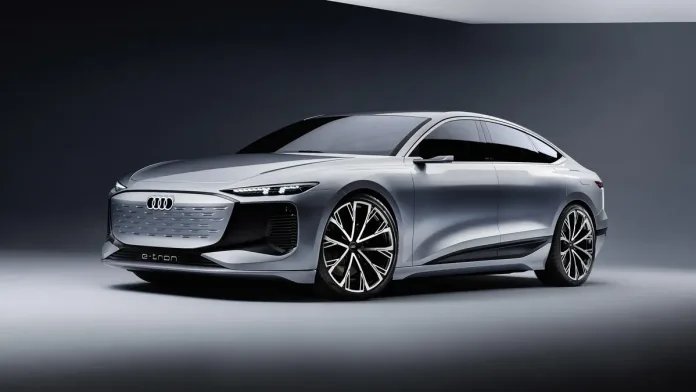The morning fog still clung to the glass and steel of Audi’s Ingolstadt facility as I made my way through security. The anticipation was palpable – not just mine, but seemingly shared by every engineer and designer I passed in the hallways. After years of development shrouded in secrecy, Audi was finally ready to pull back the curtain on what could be its most significant vehicle in decades: the 2026 Audi EV.
“This isn’t just another electric vehicle,” explained Thomas Müller, Audi’s Head of Technical Development, as he led me toward a draped silhouette in the center of the room. “It’s our answer to a question the market has been asking for years: can luxury be accessible in the electric age?”
With a theatrical flourish, the cover was removed, revealing a sleek five-door hatchback that somehow managed to look both unmistakably Audi and refreshingly new. The 2026 Audi EV represents a significant shift in the company’s approach to electric vehicles – a compact, affordable entry point to the brand that doesn’t compromise on the premium experience Audi is known for.
As the electric vehicle market continues to mature, Audi’s strategic pivot comes at a critical time. After experiencing an 11.8% drop in global sales in 2024 and a 38% decrease in operating profits, the German automaker is betting big on electrification as the path forward. This new compact EV, slated for production at the Ingolstadt facility, is at the heart of that strategy.
What Makes the 2026 Audi EV Stand Out in a Crowded Market
The compact electric vehicle segment is becoming increasingly competitive, with offerings from both traditional automakers and new EV-only brands. What makes the 2026 Audi EV different? According to Markus Duesmann, Chairman of the Board of Management at Audi, it’s about finding the perfect balance.
“We didn’t want to create just another electric car,” Duesmann told me as we walked around the vehicle. “The market is full of compromises – affordable EVs that feel cheap, or premium EVs that are financially out of reach for most consumers. We wanted to break that pattern.”
Breaking that pattern meant developing a vehicle that maintains Audi’s premium DNA while hitting a price point that opens the brand to a new segment of consumers. The 2026 Audi EV will be the brand’s smallest and most affordable electric vehicle, targeting the same segment as the current Audi A3.
While not officially an Audi A3 electric variant, the new EV will target the same market segment, potentially serving as an Audi A3 electric alternative in the company’s lineup. This positioning is strategic, allowing Audi to leverage its established reputation in the compact luxury segment while pushing forward with its electrification goals.

Inside the 2026 Audi EV: Technology and Features
Stepping inside the prototype, I’m immediately struck by how Audi has managed to make a compact interior feel spacious and premium. The cabin is dominated by screens – a 14.5-inch infotainment touchscreen takes center stage, complemented by an 11.9-inch digital instrument cluster and a 10.9-inch front passenger screen.
“The digital experience is central to this vehicle,” explained Anna Schmidt, Head of User Interface Design. “We’ve created an environment where technology enhances the driving experience without overwhelming it.”
This philosophy extends beyond the screens to the overall interior design. Sustainable materials are used throughout, with recycled fabrics and responsibly sourced wood trim creating an atmosphere that feels both luxurious and environmentally conscious.
The technology package includes:
- Advanced driver assistance systems with autonomous emergency braking
- Adaptive cruise control for comfortable highway driving
- Surround-view monitor for easy parking in urban environments
- Voice-activated controls for minimal distraction
- Over-the-air update capability to keep the vehicle current
These features represent a significant value proposition in the compact EV segment, where technology often gets scaled back to meet price targets.
Technical Specifications: Power and Performance
The 2026 Audi EV isn’t just about looks and technology – it delivers impressive performance specifications that should satisfy drivers transitioning from traditional combustion engines.
| Specification | Details |
|---|---|
| Battery Capacity | 100 kWh |
| Charging Speed | Up to 270 kW |
| Quick Charge Range | 250 km in 10 minutes |
| Base Power Output | 285 kW / 580 Nm |
| Performance Model | 360 kW (SQ6 variant) |
| Range (Performance) | 558 km |
| Range (Quattro) | 542 km |
| Range (SQ6 e-tron) | 568 km |
The battery technology in this electric vehicle allows for impressive range and charging speeds, addressing two of the most common concerns for potential EV buyers. The ability to add 250 kilometers of range in just 10 minutes of charging puts this vehicle in the top tier of EVs when it comes to convenience for longer journeys.
“Range anxiety shouldn’t be part of the luxury experience,” noted Müller. “We’ve engineered this vehicle to eliminate that concern entirely.”

How the 2026 Audi EV Compares to the Audi Q4 e-tron
While the Audi Q4 e-tron targets the mid-size SUV segment, the new compact EV will appeal to urban drivers looking for a more nimble vehicle. Lessons learned from the Audi Q4 e-tron have influenced the development of this new compact model, particularly in terms of battery management and efficiency.
The Audi Q4 e-tron provides a glimpse of the technology we might see in the 2026 compact EV, but in a more accessible package. The shared DNA is evident in the design language and technology implementation, but the new compact model represents a significant step forward in Audi’s electric evolution.
| Feature | 2026 Audi EV | Audi Q4 e-tron |
|---|---|---|
| Vehicle Type | Compact Hatchback | Mid-size SUV |
| Target Market | Urban drivers, first-time luxury buyers | Families, premium SUV buyers |
| Starting Price | Expected ~€35,000 | €47,500 |
| Range | Up to 568 km | Up to 520 km |
| Charging Speed | 270 kW | 125 kW |
| Interior Space | Compact but efficient | Spacious with SUV versatility |
This comparison highlights how Audi is strategically expanding its electric lineup to cover multiple segments and price points, with the 2026 compact EV filling an important gap in the lower end of the luxury market.
Pricing Strategy: Making Luxury Accessible
Pricing for the 2026 Audi EV is expected to be competitive within the luxury compact segment. While Audi hasn’t released official pricing yet, industry analysts suggest a starting point around €35,000 (approximately $38,000), positioning it as an entry-level luxury EV.
This affordable luxury EV will help Audi compete in a growing segment of the market that has been largely dominated by non-premium brands. By bringing its reputation for quality and refinement to a lower price point, Audi hopes to capture buyers who previously couldn’t consider the brand.
“We’re not compromising on what makes an Audi an Audi,” emphasized Duesmann. “We’re simply making that experience available to more people.”
This strategy aligns with broader industry trends, as luxury brands increasingly look to electric vehicles as a way to expand their customer base. The lower operating costs of EVs can make them more accessible over the vehicle’s lifetime, even if the initial purchase price is higher than a comparable combustion engine model.
Production and Manufacturing: The Ingolstadt Connection
The Ingolstadt production facility will be responsible for manufacturing this new electric model, underscoring Audi’s commitment to German engineering and quality control. The plant has undergone significant modifications to accommodate electric vehicle production, representing a substantial investment in Audi’s home market.
“Ingolstadt is the heart of Audi,” said production chief Peter Kössler during my tour of the facility. “It was important to us that this vehicle, which represents our future, would be built here where our story began.”
The decision to produce the vehicle in Ingolstadt comes at a time when many manufacturers are moving production to lower-cost regions. It reflects both a commitment to quality and an acknowledgment of the political importance of maintaining manufacturing jobs in Germany.
Production is scheduled to begin in early 2026, with the first vehicles reaching customers in the summer of that year. Audi plans to produce approximately 100,000 units annually, with the capacity to increase production if demand warrants.

Market Positioning: Who Is the 2026 Audi EV For?
The 2026 Audi EV is clearly targeted at a specific demographic: urban professionals who value both sustainability and luxury, but who may have previously found Audi’s offerings outside their budget. This group includes:
- Young professionals making their first luxury vehicle purchase
- Urban dwellers with limited parking who need a compact vehicle
- Environmentally conscious consumers looking to transition to electric
- Current compact luxury car owners (BMW 1 Series, Mercedes A-Class) considering electric options
- Audi enthusiasts seeking a more affordable entry point to the brand
By targeting this demographic, Audi is looking to build brand loyalty with a younger customer base that will potentially move up through their product lineup as their careers and incomes progress.
The concept of an affordable luxury EV is central to Audi’s strategy for expanding its electric lineup. Balancing premium features with accessibility, this affordable luxury EV represents Audi’s future direction in a market increasingly defined by electrification.
The Broader Context: Audi’s Electric Strategy
The 2026 Audi EV is just one piece of a much larger puzzle. Audi has announced plans to launch over 20 new or redesigned models in the next two years, with a significant portion of those being electric vehicles.
This aggressive product rollout comes as part of Volkswagen Group’s broader strategy to challenge Tesla’s dominance in the electric vehicle market. With combined investments of over $100 billion in electrification across its brands, the group is betting big on an electric future.
For Audi specifically, the strategy involves:
- Expanding the electric lineup across all segments
- Developing new platforms specifically for electric vehicles
- Investing in charging infrastructure to support customer adoption
- Gradually phasing out internal combustion engine development
This approach positions Audi to be competitive regardless of how quickly the market transitions to electric vehicles. If adoption accelerates, they’ll have the products ready; if it slows, they can adjust their production mix accordingly.
Tata Nexon vs MG Windsor Comparison: Detailed Guide in 2025
Frequently Asked Questions About the 2026 Audi EV
When will the 2026 Audi EV be available for purchase?
The vehicle is scheduled to begin production in early 2026, with the first customer deliveries expected in summer 2026. Pre-orders may open in late 2025, though Audi hasn’t confirmed exact timing.
What will the 2026 Audi EV be named?
Audi hasn’t announced the official name yet. Speculation includes A2 e-tron or A3 e-tron, following Audi’s current naming convention for electric vehicles, but this remains unconfirmed.
How much will the 2026 Audi EV cost?
While official pricing hasn’t been announced, industry analysts expect a starting price around €35,000 (approximately $38,000), making it Audi’s most affordable electric vehicle.
What is the expected range of the 2026 Audi EV?
The vehicle is expected to offer a range of up to 568 km (353 miles) on a single charge, with variations depending on the specific model variant chosen.
Will the 2026 Audi EV be available in all markets?
Audi plans to launch the vehicle globally, though timing may vary by region. Initial availability will likely focus on Europe, North America, and China, with other markets following later.
How does the 2026 Audi EV compare to Tesla models?
The 2026 Audi EV will likely compete most directly with the Tesla Model 3, offering similar range and performance but with Audi’s premium interior quality and brand prestige. It may have a slightly higher starting price but with more standard luxury features.
What charging infrastructure will the 2026 Audi EV use?
The vehicle will be compatible with CCS (Combined Charging System) fast-charging stations, which are widely available in Europe and North America. Audi is also working with partners to expand charging infrastructure ahead of the vehicle’s launch.
Will there be different versions of the 2026 Audi EV available?
Yes, Audi plans to offer multiple variants, likely including a base model, quattro all-wheel-drive version, and a performance-oriented S model, similar to their approach with other vehicles in their lineup.
The Road Ahead: What the 2026 Audi EV Means for the Future
As I prepared to leave the Ingolstadt facility, I took one last look at the prototype that represents so much of Audi’s future. In many ways, this compact electric vehicle embodies the challenges and opportunities facing the entire automotive industry: how to maintain brand identity while embracing new technology, how to balance premium experiences with accessibility, and how to navigate the transition from combustion to electric power.
The 2026 Audi EV isn’t just another model in the lineup – it’s a statement of intent. It declares that Audi believes the future of mobility is electric, that luxury can be accessible, and that the brand’s values can translate into this new era.
“We’re not just building a new car,” Duesmann told me as we said our goodbyes. “We’re building a bridge to Audi’s future.”
For consumers, that future looks increasingly bright. The 2026 Audi EV promises to deliver the quality, technology, and driving experience that the brand is known for, but at a price point that opens those experiences to a broader audience. In doing so, it may just redefine what we expect from an entry-level luxury vehicle in the electric age.
As the automotive landscape continues to evolve, one thing is clear: Audi isn’t content to follow the path others have laid. With the 2026 Audi EV, they’re charting their own course toward an electric future – one that stays true to their heritage while embracing the possibilities of tomorrow.


